Abstract
Background:
The aim of this study was to determine the cumulative prevalence rate of every sexual dysfunctions (SDs) in Iranian population.
Methods:
We searched international database such as: PubMed/Medline, Scopus, PsychNET, and Scholar Google and Iranian database such as Iran Psych, IranDoc, IranMedex, and SID. Search duration was between 1990 and 2013.
Results:
From 449 articles were retrieved, then 11 articles on male with total sample size of 2142 and 8 articles on female with total sample size of 4391 were selected after critical appraisal. For quality assessment check list to evaluate a prevalence article was contained study population, sampling method, sample size, criteria for SD diagnosis, specific rates, study location, and authors list. In male, erectile dysfunction was 56.1%. In female, pooled estimation prevalence of hypoactive sexual desire disorder in complained group was 65.8% (95% confidence interval [CI]: 51.1-80.6%) compared to general population 35% (95% CI: 17.6-52.1%). Sexual arousal disorder in clinical patient was 59.6% (95% CI: 39-80%) against 33.8% (95% CI: 18.3-49.3%) in general population. Orgasmic disorder in complained was 35.5% (95% CI: 16-55%) and in general population was 35.3% (95% CI: 26.8-43.8%). Sexual pain disorder pooled estimation prevalence were 35.2% (95% CI: 14.5-56%) versus 20.1% (95% CI: 6.4-33.8%) in complained and general population consecutively.
Conclusions:
The rate of SD in Iran was approximately the same of worldwide except orgasmic disorder which was two times more than the worldwide average.
Keywords: Epidemiology, Iran, sexual dysfunction, sexuality, systematic review
INTRODUCTION
Research regarding sexual health domains in Iran is scarce because of many cultural contexts and social stigmas. However, changes in contemporary Iranian society are associated with increases in the rate of extramarital sexual activity and sex partner changes. Due to the transformation of transmission patterns for acquired immune deficiency syndrome and enhanced transmission via sexual activity, health policy makers and researchers have been directed toward investigating sexual behaviors in the Iranian population.[1]
According to socio-cultural changes of modern Iran, the mean age of first sexual experience has decreased over the last decade. Mohammad and colleagues have determined that approximately 28% of adolescent Iranian boys, aged between 15 and 18, reported having sexual relations.[2] Another study on girls-mean age 21 years showed that 23% have had some type of sexual contact and 10% have had intercourse.[3]
On the other hand, sexual issues are an unavoidable part of marriage and couples’ sexuality is one of the most important and integral parts of marital satisfaction. Sexual dysfunctions (SD) decrease marital satisfaction and may be the trigger for conflict and divorce.[4,5] SD can be treated medically or psychologically.[6]
Sexual dysfunctions are a heterogeneous group of disorders, which are typically characterized by a clinically significant disturbance in a person's ability to respond sexually or to experience sexual pleasure.[7] SD, as defined by the new version of the Diagnostic and Statistical Manual of Mental Disorder (DSM-V) has been divided into several categories, including delayed ejaculation, erectile disorder, female orgasmic disorder, female sexual interest/arousal disorder, genito-pelvic pain/penetration disorder, male hypoactive sexual desire disorder (HSDD), premature (early) ejaculation, substance/medication induced SD, other specified SD, and unspecified SD.[7]
Sexual dysfunctions in females are more prevalent than in males. Many actors including physiological, anatomical, and socio-cultural affect SDs.[8] The most prevalent SD in females is hypoactive desire disorder, whereas in men, premature ejaculation (PE) is the most frequent disorder.[8] There is an urgent need for research to focus on this issue in Iran
The first step on any such investigation is to undertake an epidemiological study. These studies can help policy makers in planning and decision-making. To date, no cumulative data exist about the frequency of SDs in Iranian people. Cultural context, social limitation, religious directions, and methodological issues prohibit the study of sexual mores, behaviors, and dysfunctions. One way to bypass this challenge is to systematically review and undertake secondary data analysis. The current study, therefore, was designed to review papers and reports regarding SDs and collected data about the frequency of SDs, and to come up with a cumulative rate. The Study objective was to calculate the cumulative prevalence rate of every SDs in Iranian population in a systematic review and meta-analysis.
METHODS
Study design and search strategy
We conducted a systematic review. Specifically, for this review, we focused on two objectives: (1) To identify literatures which represent frequency of SD separately in male and female, (2) to stratify literature and present cumulative prevalence rate. Four international online databases were searched:
PubMed: Scopus, PsycNET,, and Scholar Google.
Besides, we searched four Iranian databanks including:
Iran Psych, SID, IranMedex, and IranDoc.
The Iranian databases were contained dissertation and thesis as unpublished data, too. The main keywords to search international database contained Iran, which combined with the terms related to sex and sexuality: (sexual OR sexuality) AND Iran. The Persian keywords were equivalent to their English words and all probable combinations were considered. Considering the limitation in the use of a large number of keywords and the simultaneous use of the logical operators “AND” and “OR,” each group of keywords were separately searched in the databanks and duplicated documents were removed.[9] Due to the scarcity of relevant articles based on SDs in Iran; the literature search was expanded to include 23 years of research from 1990 to 2013. All searching procedures were completed between October and December 2012. Moreover, the reference lists of retrieved studies were screened for additional relevant studies. All references were stored in the reference database program reference manager 10.
Selection criteria and data extraction
After searching database, two authors read all defined titles and abstracts, independently and selected eligible article for critical appraisal. The full texts of all relevant articles were assessed. Because of SD varieties, studies were independently selected and were included in case they were original and provided estimates of every SD frequency. Following information was extracted: publication date, study population and location, sample size, used instrument.
Quality assessment and analysis model
For quality assessment, we used a checklist to evaluate a prevalence article. It was contained study population, sampling method, sample size, criteria for SD diagnosis, specific rates, study location, and authors list. We included studies with a random selection, the same instrument for SD assessment separately in male and female, accurate statistical rates and only in Iranian population. Exclusion criteria for articles were doubtful sampling method, unknown instrument or unusual ones, and unfair analysis.
Every Persian language paper was compared to similar English article to prevent duplication. All papers were divided to male and female SDs. Four groups of SD were evaluated: HSDD, sexual arousal disorder (SAD) which erectile dysfunction (ED) is for male; sexual orgasmic disorder (SOD) which PE is for male; and sexual pain disorder (SPD). We used criteria of DSM-IV-R because a new version (DSM-V) has not been published during study time.
Data analysis
After that, we used STATA software, version 10 (College station, Stata Corporation, TX, USA) to analyze data extracted from articles. The variance of current prevalence of each SD in each study was computed based on the binomial distribution formula. Random effect model was applied to estimate the combined mean prevalence of each SD separated by gender. Analysis was done in the general population and specific population separately. This specific population were group of people with other physical disease that name complained group. We presented forest plot for each analysis.
RESULTS
Sexual dysfunctions have gender entity. We separated retrieved research to male and female SD. From 449 retrieved articles, we identified 19 appropriate papers published between 1990 and 2013 reporting SD frequency. Of these studies, 11 reported on male sample with total sample size of 2142 men and 8 reported on female sample with total sample size of 4391 women, selected for systematic review. The process of article selection has been shown in Figure 1.
Figure 1.
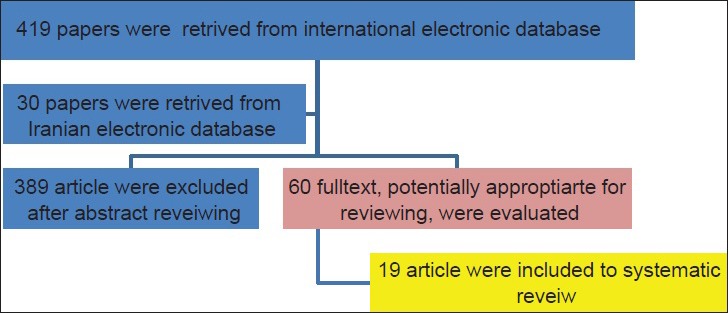
The flowchart of article selection
Male sexual dysfunction
Two main categories of SD in men were ED and PE. In some resource, ED is considered as impotency and most important SD in males. ED prevalence was frequent due to study population. It was between 14% and 87.7%. Table 1 shows studies regarding ED in different population in Iran. Meta-analysis is done for 11 studies revealed the pooled prevalence estimation 56.1% (95% confidence interval [CI]: 40-72%). Figure 2 shows the forest plot of these eleven studies and pooled estimations. Zargooshi-2008 has reported 21.3% of unconsummated marriage was due to PE. But there was not any other definite study around PE and other male SD prevalence in Iran.
Table 1.
List of selected article in a systematic review from male sexual dysfunction
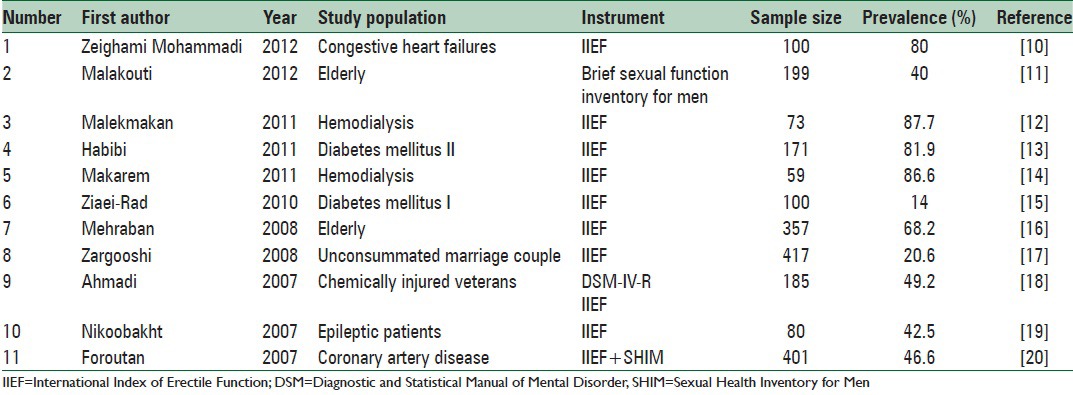
Figure 2.
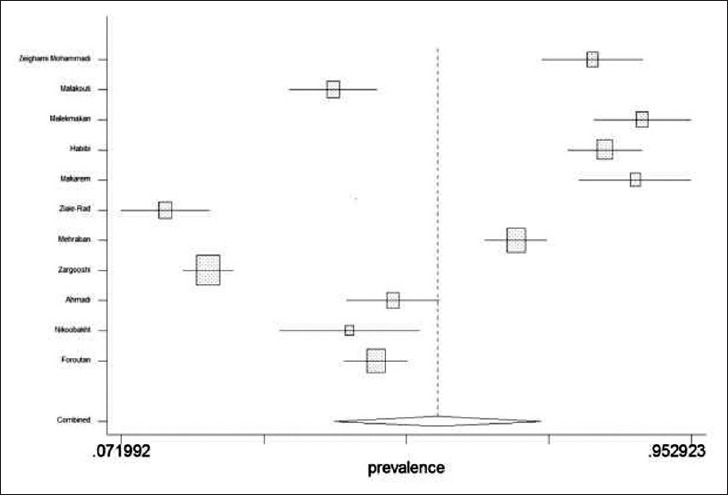
The forest plot of current prevalence of erectile dysfunction in Iranian population
Female sexual dysfunction
There were more studies regarding female SD based on the types of SD. They have been shown in Table 2. The studies were divided into two groups for meta-analysis. First one, prevalence was calculated in specific or complained population and second was in the general population like as male SD.
Table 2.
List of selected article in a systematic review for female sexual dysfunction
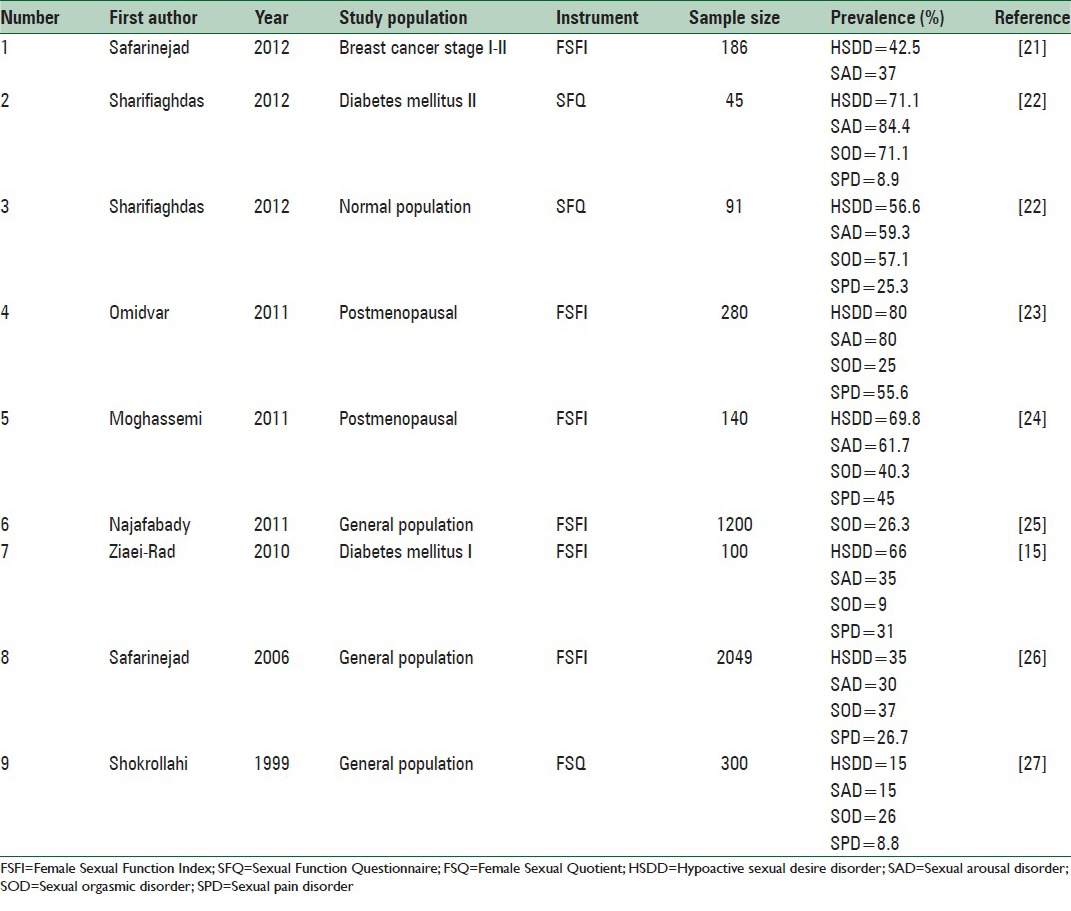
Pooled estimation of HSDD prevalence in complained group was 65.8% (95% CI: 51.1-80.6%). In contrast to this group, the prevalence rate of HSDD in Iranian women in the general population was 35% (95% CI: 17.6-52.1%). Figure 3 presents distributions of HSDD, as a forest plot in meta-analysis.
Figure 3.
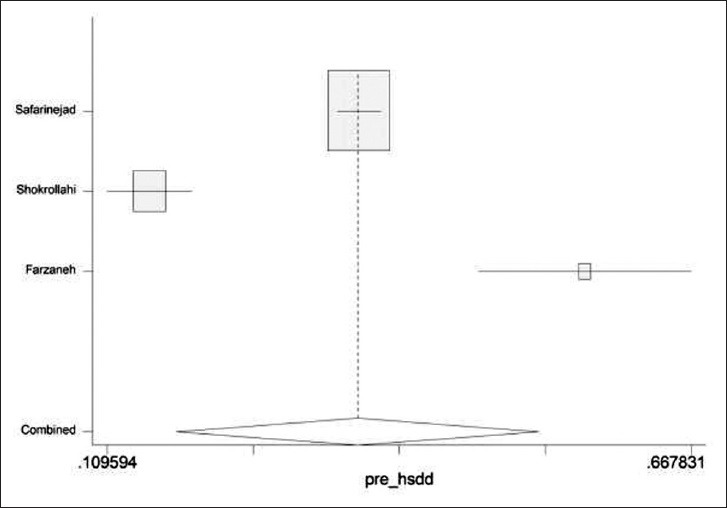
The forest plot of current prevalence of hypoactive sexual desire disorder in female general population in Iran
In SAD, pooled prevalence in complained group was 59.6% (95% CI: 39-80%), while the prevalence of SAD in general population was 33.8% (95% CI: 18.3-49.3%). Distributions of SAD were shown in Figure 4.
Figure 4.

The forest plot of current prevalence of sexual arousal disorder in female general population in Iran
SOD had the same pooled prevalence in both groups. In complained group was 35.5% (95% CI: 16-55%) and in general population was 35.3% (95% CI: 26.8-43.8%). Figure 5 shows the Forest plot of pooled prevalence of SOD in the general population.
Figure 5.
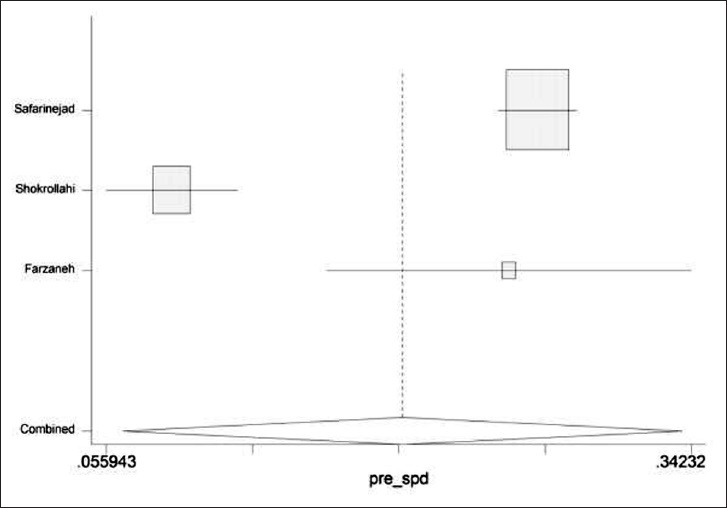
The forest plot of current prevalence of sexual orgasmic disorder in female general population in Iran
At the end, SPD pooled estimation prevalence was 35.2% (95% CI: 14.5-56%) in complained. It is believable that the prevalence rate in the general population is lower: 20.1% (95% CI: 6.4-33.8%). Related distribution is illustrated in Figure 6.
Figure 6.
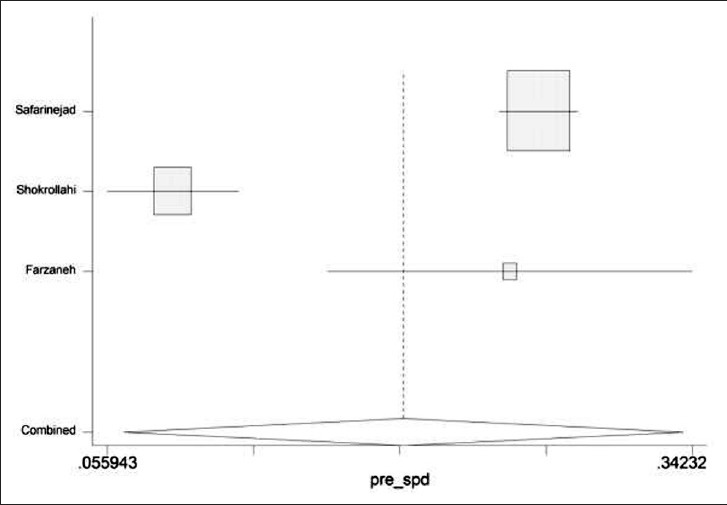
The forest plot of current prevalence of sexual pain disorder in female general population in Iran
DISCUSSION
The prevalence of SDs in Iran is unknown, and yet knowing the prevalence rate is one of the most important criteria that health policy makers and health care providers need for developing nationwide policies. On the other hand, awareness about the frequency of SDs facilitates other related studies. This is the first report of a systematic review and meta-analysis regarding SD frequency in Iran.
SDs were divided based on gender. In males, ED and PE, indicators of male SD, were more frequent. Our analysis shows that the prevalence of ED is three times higher in specific population than has been reported in the Iranian general population was 18%.[28] In addition, the rate is nearly 4 times greater than in Hong Kong, where prevalence of ED is 4.3% in the general population.[29] Certainly, the prevalence rate of SD increases under specific conditions like chronic diseases. In particular, Collins et al. stated the frequency of ED in chronic obstructive pulmonary disease patients was 72%,[30] which is close to what we find in Iran. We could not find many studies which report on male SD in the general population in Iran. According to the DSM-V, there is a strong age-related increase in both prevalence and incidence of problems with erection, particularly after age 50. Approximately 13-21% of men ages 40-80 years complain of occasional problems with erections.[7] The age range in our study was 40-70 years old. Perhaps, this is one of the reasons that ED rate was so high in our study.
One advantage of our study on the assessment of ED was the uniformity of assessment tools used. In ED, all studies that were reviewed by our research team and entered into the analysis had used the International Index of Erectile Dysfunction, which greatly aided in increasing the internal validity of our study. Another advantage was the homogeneity of the population selected for the analysis: we omitted studies that did not meet these criteria. Our limitation in the study of male SD was the lack of study of other dysfunctions such as PE and HSDD.
On the other hand, female SDs are considerable that studies have shown higher rates than male SDs rates. It is maybe due to better tools for assessment or overt presentation or nature of sex or socio-cultural context in Iran for women. It is clear that all female sexual dysfunctions (FSDs) are higher in specific conditions like chronic diseases than the general population. It is confirmed by new studies worldwide.[31,32] Pontiroli et al. determined in a recent meta-analysis that SD increase in Diabetic patients while weight and age are independent factors for this enhancement.[33] Grewal et al. 2013 reported overall prevalence of FSD in Malaysia 5.5% and has not divided to subtype of FSD.[34] It is less than our finding in Iran. However, our finding determined that SOD did not have any difference between the general population and specific group patients. In both groups, frequency was approximately 35%. This finding shows that the frequency of SOD in Iranian females is very high. It refers to the lack of knowledge regarding sexual issues and many deep beliefs around sexuality and women sexual life in Iranian girls and women. SOD is more prevalent of SDs in some other countries.[35,36] Reported prevalence rates for female orgasmic problems in women vary widely, from 10% to 42%, depending on multiple factors (e.g. age, culture, duration, and severity of symptoms).[7]
Hypoactive sexual desire disorder is one of the most frequent problems which finds in the couple therapy and the practice of sex; up to 30% of women are affected by low or absent sexual interest and desire.[37] HSDD has high frequency not only in the world but also in Iran. In our study, HSDD is the most frequent sexual problem in Iranian women. As the result of ours, HSDD in Simons’ study was the first rank.[38] The incidence is higher in a specific population. More than half of couples in treatment complain of insufficient sexual desire within their relationship. HSDD is multi-factorial dysfunction. Individuals, interpersonal, intergenerational, and physical health factors affect on sexual desire and interest.[39] Based on new sexual desire and interest cycle in female, definition of HSDD in female has been changed to Female sexual interest/arousal disorder, and the frequency of it is unknown. However, the prevalence of HSDD as defined by DSM-IV may vary markedly in relation to age, cultural setting, duration of symptoms, and the presence of distress.[7,40]
The prevalence of sexual pain in women has been estimated approximately 14%, with significant variation across the lifespan.[41] The prevalence of SPD in our study was a little higher than aforementioned rate (20% vs. 14%). Approximately, 15% of women in North America experience painful intercourse,[7] which is near to our data in Iran.
Overall, FSD in our finding confirmed to worldwide FSD rate.[42] Only SOD is higher in Iran frequently. However, we should consider in many issues in the current study. The first issue is a methodology, the difference between original studies and meta-analysis. Heterogeneity in studies is one of the most important factors in meta-analysis. Heterogeneity in the findings of different studies could be due to many factors such as their sampling methods, the quality and the method of diagnosis or their different definitions of the disease in population, and their diversities in the age and gender.[9] The use of different instrument was the only source of heterogeneity in our meta-analysis. However, questionnaires that have designed to evaluate SD, intimate from DSM-IV criteria. Thus, the findings have been represented from these questionnaires were the same. Tables 1 and 2 determine the instruments that were used in Iranian studies. We tried to reduce heterogeneity in critical appraisal phase by selecting the studied with the similar diagnostic tools.
The other problem in meta-analysis is publication bias that may distort the findings; in this study, we searched all available data sources to cover gray literature, as well.
As the Sadeghirad et al. study, we have some limitation in our meta-analysis. We should acknowledge the limitations of using meta-analysis technique in descriptive observational studies. The main limitation is that the estimated prevalence was not adjusted based on the size of the target population. However, it seems that meta-analysis could be a feasible and efficient method to utilize the findings of all relevant studies appropriately.[9]
CONCLUSIONS
Finally, it should be considered that sexual issues and SDs are the new domain for research in Iran because of behavioral changes and transition in Iran. Pre-marriage relationship and extramarital relationship are hidden in Iran and considering to rise in Iranian society. Any intimated relationships (particularly sexual ones) between men and women outside of marriage are socially, culturally, legally and religiously forbidden in Iran. This plurality causes psychological conflict between couples and showed itself in a sexual relationship. Sexual beliefs such as these: (1) Sex is dirty and guilt. (2) Sex should happen only if a man initiates. (3) A good mother must control her sexual urges. (4) A good mother cannot be sexually active are the other factors that affect on sexual function. We recommended appropriate and modified psycho-sexual education based on cultural and religious issues are needed for young men and women.
New well-designed epidemiological studies with good interventional strategies are essential for developed research in Iran.
ACKNOWLEDGEMENTS
We thank Dr. Aliakbar Haghdoost-Prof. of epidemiology in Kerman University of Medical Sciences to help as in the analysis and consult us in this study. We are grateful to Dr. Alireza Ghaforian, who assisted to obtain full-text article and appreciate to all member of behavioral sciences research center, Baqiyatallah University of Medical Sciences for cooperation.
Footnotes
Source of Support: Nil
Conflict of Interest: None declared.
REFERENCES
- 1.Nasirian M, Haghdoost AA. Kerman, Iran: Kerman University of Medical Sciences; 2011. Modeling of New HIV Infections Based on Exposure Groups in Iran. [Google Scholar]
- 2.Mohammad K, Farahani FK, Mohammadi MR, Alikhani S, Zare M, Tehrani FR, et al. Sexual risk-taking behaviors among boys aged 15-18 years in Tehran. J Adolesc Health. 2007;41:407–14. doi: 10.1016/j.jadohealth.2007.05.003. [DOI] [PubMed] [Google Scholar]
- 3.Farahani FK, Cleland J, Mehryar AH. Associations between family factors and premarital heterosexual relationships among female college students in Tehran. Int Perspect Sex Reprod Health. 2011;37:30–9. doi: 10.1363/3703011. [DOI] [PubMed] [Google Scholar]
- 4.Barikani A, Ebrahim SM, Navid M. The cause of divorce among men and women referred to marriage and legal office in Qazvin, Iran. Glob J Health Sci. 2012;4:184–91. doi: 10.5539/gjhs.v4n5p184. [DOI] [PMC free article] [PubMed] [Google Scholar]
- 5.Xiao Z, Mehrotra P, Zimmerman R. Sexual revolution in China: implications for Chinese women and society. AIDS Care. 2011;23(Suppl 1):105–12. doi: 10.1080/09540121.2010.532537. [DOI] [PubMed] [Google Scholar]
- 6.Frühauf S, Gerger H, Schmidt HM, Munder T, Barth J. Efficacy of psychological interventions for sexual dysfunction: a systematic review and meta-analysis. Arch Sex Behav. 2013;42:915–33. doi: 10.1007/s10508-012-0062-0. [DOI] [PubMed] [Google Scholar]
- 7.5th ed. Washington, DC, USA: American Psychiatric Publishing; 2013. APA. Diagnostic and Statistical Manual of Mental Disorder (DSM-V) [Google Scholar]
- 8.Chung E, Brock GB. Sexual dysfunction in 2011: advances in epidemiology, pathophysiology and treatment. Nat Rev Urol. 2012;9:66–8. doi: 10.1038/nrurol.2011.223. [DOI] [PubMed] [Google Scholar]
- 9.Sadeghirad B, Haghdoost AA, Amin-Esmaeili M, Ananloo ES, Ghaeli P, Rahimi-Movaghar A, et al. Epidemiology of major depressive disorder in Iran: a systematic review and meta-analysis. Int J Prev Med. 2010;1:81–91. [PMC free article] [PubMed] [Google Scholar]
- 10.Zeighami Mohammadi S, Shahparian M, Fahidy F, Fallah E. Sexual dysfunction in males with systolic heart failure and associated factors. ARYA Atheroscler. 2012;8:63–9. [PMC free article] [PubMed] [Google Scholar]
- 11.Malakouti SK, Salehi M, Nojomi M, Zandi T, Eftekhar M. Sexual functioning among the elderly population in Tehran, Iran. J Sex Marital Ther. 2012;38:365–77. doi: 10.1080/0092623X.2011.628438. [DOI] [PubMed] [Google Scholar]
- 12.Malekmakan L, Shakeri S, Haghpanah S, Pakfetrat M, Sarvestani AS, Malekmakan A. Epidemiology of erectile dysfunction in hemodialysis patients using IIEF questionnaire. Saudi J Kidney Dis Transpl. 2011;22:232–6. [PubMed] [Google Scholar]
- 13.Habibi A, Kalbasi S, Saadatjoo SA, Arefi MG. Evaluation of Erectile Dysfunction and Associated Factors in Type-II Diabetic Patients in Birjand, Iran in 2008-2009. J Res Health Sci. 2011;11:97–102. [PubMed] [Google Scholar]
- 14.Makarem AR, Karami MY, Zekavat OR. Erectile dysfunction among hemodialysis patients. Int Urol Nephrol. 2011;43:117–23. doi: 10.1007/s11255-010-9780-1. [DOI] [PubMed] [Google Scholar]
- 15.Ziaei-Rad M, Vahdaninia M, Montazeri A. Sexual dysfunctions in patients with diabetes: a study from Iran. Reprod Biol Endocrinol. 2010;8:50. doi: 10.1186/1477-7827-8-50. [DOI] [PMC free article] [PubMed] [Google Scholar]
- 16.Mehraban D, Naderi GH, Yahyazadeh SR, Amirchaghmaghi M. Sexual dysfunction in aging men with lower urinary tract symptoms. Urol J. 2008;5:260–4. [PubMed] [Google Scholar]
- 17.Zargooshi J. Male sexual dysfunction in unconsummated marriage: long-term outcome in 417 patients. J Sex Med. 2008;5:2895–903. doi: 10.1111/j.1743-6109.2008.01004.x. [DOI] [PubMed] [Google Scholar]
- 18.Ahmadi K, Ranjebar-Shayan H, Raiisi F. Sexual dysfunction and marital satisfaction among the chemically injured veterans. Indian J Urol. 2007;23:377–82. doi: 10.4103/0970-1591.36710. [DOI] [PMC free article] [PubMed] [Google Scholar]
- 19.Nikoobakht M, Motamedi M, Orandi A, Meysamie A, Emamzadeh A. Sexual dysfunction in epileptic men. Urol J. 2007;4:111–7. [PubMed] [Google Scholar]
- 20.Foroutan SK, Rajabi M. Erectile dysfunction in men with angiographically documented coronary artery disease. Urol J. 2007;4:28–32. [PubMed] [Google Scholar]
- 21.Safarinejad MR, Shafiei N, Safarinejad S. Quality of life and sexual functioning in young women with early-stage breast cancer 1 year after lumpectomy. Psychooncology. 2013;22:1242–8. doi: 10.1002/pon.3130. [DOI] [PubMed] [Google Scholar]
- 22.Sharifiaghdas F, Azadvari M, Shakhssalim N, Roohi-Gilani K, Rezaei-Hemami M. Female sexual dysfunction in type 2 diabetes: a case control study. Med Princ Pract. 2012;21:554–9. doi: 10.1159/000339118. [DOI] [PubMed] [Google Scholar]
- 23.Omidvar S, Bakouie F, Amiri FN. Sexual function among married menopausal women in Amol (Iran) J Midlife Health. 2011;2:77–80. doi: 10.4103/0976-7800.92534. [DOI] [PMC free article] [PubMed] [Google Scholar]
- 24.Moghassemi S, Ziaei S, Haidari Z. Female sexual dysfunction in Iranian postmenopausal women: prevalence and correlation with hormonal profile. J Sex Med. 2011;8:3154–9. doi: 10.1111/j.1743-6109.2011.02335.x. [DOI] [PubMed] [Google Scholar]
- 25.Najafabady MT, Salmani Z, Abedi P. Prevalence and related factors for anorgasmia among reproductive aged women in Hesarak, Iran. Clinics (Sao Paulo) 2011;66:83–6. doi: 10.1590/S1807-59322011000100015. [DOI] [PMC free article] [PubMed] [Google Scholar]
- 26.Safarinejad MR. Female sexual dysfunction in a population-based study in Iran: prevalence and associated risk factors. Int J Impot Res. 2006;18:382–95. doi: 10.1038/sj.ijir.3901440. [DOI] [PubMed] [Google Scholar]
- 27.Shokrollahi P, Mirmohamadi M, Mehrabi F, Babaei G. Prevalence of sexual dysfunction in women seeking services at family planning centers in Tehran. J Sex Marital Ther. 1999;25:211–5. doi: 10.1080/00926239908403995. [DOI] [PubMed] [Google Scholar]
- 28.Safarinejad MR. Prevalence and risk factors for erectile dysfunction in a population-based study in Iran. Int J Impot Res. 2003;15:246–52. doi: 10.1038/sj.ijir.3901024. [DOI] [PubMed] [Google Scholar]
- 29.Zhang H, Yip AW, Fan S, Yip PS. Sexual dysfunction among Chinese married men aged 30-60 years: a population-based study in Hong Kong. Urology. 2013;81:334–9. doi: 10.1016/j.urology.2012.11.003. [DOI] [PubMed] [Google Scholar]
- 30.Collins EG, Halabi S, Langston M, Schnell T, Tobin MJ, Laghi F. Sexual dysfunction in men with COPD: impact on quality of life and survival. Lung. 2012;190:545–56. doi: 10.1007/s00408-012-9398-4. [DOI] [PubMed] [Google Scholar]
- 31.Ferreira CD, da Mota LM, Oliveira AC, de Carvalho JF, Lima RA, Simaan CK, et al. Frequency of sexual dysfunction in women with rheumatic diseases. Rev Bras Reumatol. 2013;53:35–46. doi: 10.1016/s2255-5021(13)70004-x. [DOI] [PubMed] [Google Scholar]
- 32.Virseda-Chamorro M, Salinas-Casado J, Lopez-Garcia-Moreno AM, Cobo-Cuenca AI, Esteban-Fuertes M. Sexual dysfunction in men with spinal cord injury: a case-control study. Int J Impot Res. 2013;25:133–7. doi: 10.1038/ijir.2013.1. [DOI] [PubMed] [Google Scholar]
- 33.Pontiroli AE, Cortelazzi D, Morabito A. Female sexual dysfunction and diabetes: a systematic review and meta-analysis. J Sex Med. 2013;10:1044–51. doi: 10.1111/jsm.12065. [DOI] [PubMed] [Google Scholar]
- 34.Grewal GS, Gill JS, Sidi H, Gurpreet K, Jambunathan ST, Suffee NJ, et al. Prevalence and risk factors of female sexual dysfunction among healthcare personnel in Malaysia. Compr Psychiatry. 2014;55(Suppl 1):S17–22. doi: 10.1016/j.comppsych.2013.01.009. [DOI] [PubMed] [Google Scholar]
- 35.Fajewonyomi BA, Orji EO, Adeyemo AO. Sexual dysfunction among female patients of reproductive age in a hospital setting in Nigeria. J Health Popul Nutr. 2007;25:101–6. [PMC free article] [PubMed] [Google Scholar]
- 36.Cabral PU, Canário AC, Spyrides MH, Uchôa SA, Eleutério J, Jr, Gonçalves AK. Determinants of sexual dysfunction among middle-aged women. Int J Gynaecol Obstet. 2013;120:271–4. doi: 10.1016/j.ijgo.2012.09.023. [DOI] [PubMed] [Google Scholar]
- 37.Laumann EO, Paik A, Rosen RC. Sexual dysfunction in the United States: prevalence and predictors. JAMA. 1999;281:537–44. doi: 10.1001/jama.281.6.537. [DOI] [PubMed] [Google Scholar]
- 38.Simons JS, Carey MP. Prevalence of sexual dysfunctions: results from a decade of research. Arch Sex Behav. 2001;30:177–219. doi: 10.1023/a:1002729318254. [DOI] [PMC free article] [PubMed] [Google Scholar]
- 39.Segraves KB, Segraves RT. Hypoactive sexual desire disorder: prevalence and comorbidity in 906 subjects. J Sex Marital Ther. 1991;17:55–8. doi: 10.1080/00926239108405469. [DOI] [PubMed] [Google Scholar]
- 40.Basson R, Wierman ME, van Lankveld J, Brotto L. Summary of the recommendations on sexual dysfunctions in women. J Sex Med. 2010;7:314–26. doi: 10.1111/j.1743-6109.2009.01617.x. [DOI] [PubMed] [Google Scholar]
- 41.Meana M. Painful intercourse, dyspareunia and vaginismus. In: Hertlein KM, Weeks GR, Gambescia N, editors. Systemic Sex Therapy. 1st ed. New York: Routledge Taylor and Francis Group; 2009. pp. 238–59. [Google Scholar]
- 42.Frank JE, Mistretta P, Will J. Diagnosis and treatment of female sexual dysfunction. Am Fam Physician. 2008;77:635–42. [PubMed] [Google Scholar]


